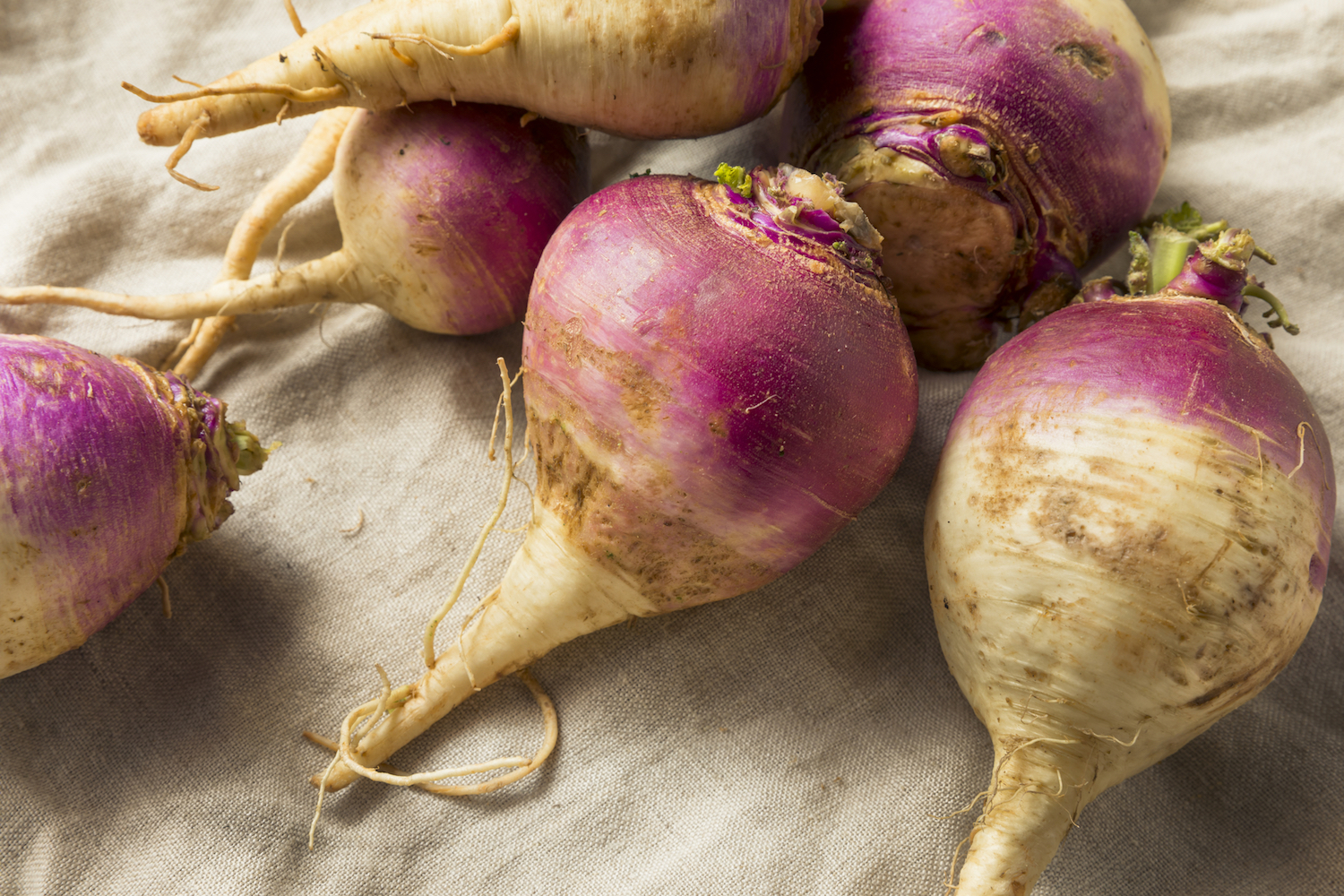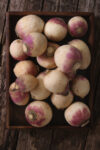
Interesting Ways to Cook Turnips
Turnips were brought to American colonies by early European settlers and grow best in cool climates. Spring varieties don’t keep very long, but winter varieties can be stored in a cool place for a couple of months. So early Americans were able to enjoy turnips and other root vegetables during the cold winter months.
INFORMATION BELOW FROM 1800s COOKBOOKS
Turnips have a strong flavor, which is disliked by many persons and disagrees with some. However, much of this can be dissipated by cooking them with the cover of the kettle removed. They have good storing qualities and can be kept very easily through the winter.
Toward spring, it is more difficult to cook them soft, as the cellulose in them becomes harder and they are likely to develop woody fiber.
Setting in the sun after they are cooked, or on a part of the table upon which the sun may happen to shine, will give to turnips a singularly unpleasant taste, and should therefore he avoided.
Mutton, either boiled or roasted, should always be accompanied by turnips.
PREPARATION AND COOKING
Select turnips which are plump and free from disease. A turnip that is wilted, or that appears spongy, pithy, or cork-like when cut, is not fit for food.
Prepare turnips for cooking by thoroughly washing and scraping, if young and tender, or by paring if more mature. If small, they may be cooked whole. If large, they should be cut across the grain into slices a half inch in thickness. If cooked whole, care must be taken to select those of uniform size, and if sliced, the slices must be of equal thickness.The white lining just inside the skin is usually bitter; hence the tuber should be peeled sufficiently deep to remove it. When well cooked, turnips are quite easily digested.
TURNIP-TOPS
Turnip-tops are the shoots which grow out (in the spring) of the old turnip-roots. They make very nice sweet greens and are esteemed great purifiers of the blood. Put them into cold water an hour before they are to be dressed. The more water they are boiled in, the better they will look. If boiled in a small quantity of water, they will taste bitter. When the water boils, put in a small handful of salt and then your vegetables. If fresh and young, they will be done in about twenty minutes. Drain them on the back of a sieve. They should then be cut up with a knife and fork very finely and served like spinach.
BOILED TURNIPS
Turnips, like other vegetables, should be boiled in as small an amount of water as possible. Too much cooking discolors and renders them strong in flavor.
Boiled turnips should be drained very thoroughly, and all water pressed out before preparing for the table. The age, size, and variety of the turnip will greatly vary the time necessary for its cooking. The safest rule is to allow plenty of time, and test with a fork.
Put three tablespoons butter in a saucepan and as soon as it is melted, put in one small onion, minced fine, and one quart of turnips cut in dice. Stir until they are brown, then add one teaspoon salt, the same of sugar, one tablespoon flour and one-half saltspoon* pepper, stirring for two minutes. Then add a cup of milk or stock and simmer for twenty minutes, keeping the saucepan covered. Serve immediately.
*saltspoon – a miniature spoon used with an open salt cellar for individual use before table salt was free-flowing. One saltspoon equals one-fourth teaspoon.
SCALLOPED TURNIPS
Prepare and boil whole white turnips until nearly tender. Cut into thin slices, lay in an earthen pudding dish, and pour over them a white sauce sufficient to cover. Make the sauce by cooking a tablespoon of flour in a pint of milk, part cream if preferred, until thickened. Then season with salt, sprinkle the top lightly with grated bread crumbs, and bake in a quick oven* until a rich brown. Place the baking dish on a clean plate and serve. Rich milk or cream may be used instead of white sauce, if preferred.
*quick oven – about 400-450 degrees Fahrenheit
YOUNG TURNIPS BOILED WHOLE
When turnips are very young, it is customary to serve them up with about two inches of the green top left on them. Pare smoothly, and trim all into the same size and shape. Lay in cold water half an hour. Put them in boiling water with one tablespoon butter and stew until tender. Drain dry without crushing or breaking them, then pile in a deep dish and cover with a white sauce. Turnips should always be eaten very hot.
MASHED TURNIPS
Old turnips are best mashed, as they are stringy. Scrub and pare six medium turnips and cut each into cubes. Place them in the top part of a steamer and cook until tender when tested with a fork or knitting needle. Mash the turnips with a potato masher, then add two tablespoons butter and enough salt and pepper to season. The addition of a little sugar is considered an improvement by some. Serve hot.
BAKED TURNIPS
Select turnips of uniform size. Wash and wipe, but do not pare. Place on the top grate of a moderately hot oven. Bake two or more hours or until perfectly tender. Peel and serve at once, either mashed or with cream sauce. Turnips are much sweeter baked than when cooked in any other way.
TURNIPS AND POTATOES
Persons who are likely to find the flavor of turnips disagreeable can usually eat them when they are combined with potatoes. Pare an equal number of Irish [white] potatoes and turnips and cut them into thick slices. Put them to cook in boiling salted water and cook with the cover off the kettle until both are tender. Drain and dress with butter or add butter and mash together. Serve hot.
TURNIP SALAD
Slice very thin three or four turnips and put them to soak overnight. Change the water the next morning, then cut up very fine. Put on salt, pepper, and celery salt or celery seed, and vinegar.
TURNIP SOUP
Wash, peel, and cut up ten turnips, two onions, two potatoes, and one small stick of celery. Dissolve two ounces butter in a large saucepan, then place in the sliced vegetables. Add two teaspoons salt, one teaspoon peppercorns, and three pints water. Boil gently for two hours. Strain, return to the saucepan, which must be perfectly clean, add milk, simmer a few minutes and serve.
Note – A tablespoon of cream placed in the tureen and stirred into the soup as it is poured in, is a great improvement, or it may be thickened with one tablespoon sago.
=================================================

.
Discover the fascinating history and lore of 29 major roots, their nutritional content, how to buy and store them, and much more, from the familiar (beets, carrots, potatoes) to the unfamiliar (jicama, salsify, malanga) to the practically unheard of (cassava, galangal, crosnes). In hardback, paperback, or kindle formats.
=================================================
Are you a fan of turnips? Please leave a comment below.
=================================================

2 thoughts on “Interesting Ways to Cook Turnips”
I never thought to make a white sauce and do turnips as a scallop dish, what a great idea. I’m going to have to try that.
I’m thinking of giving turnips another try, too. Besides the scalloped turnips, the turnip salad sounds good.